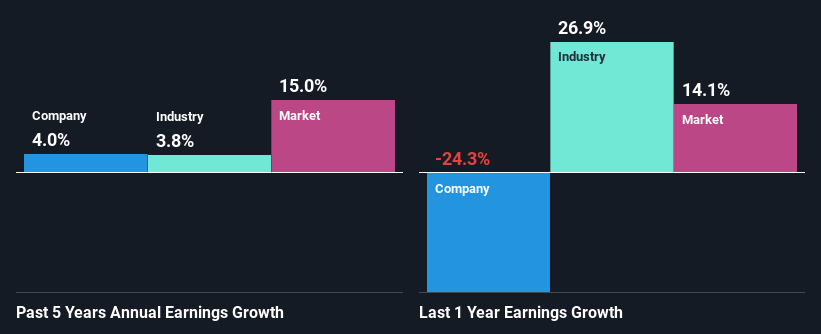UniFirst Corporation's (NYSE:UNF) Fundamentals Look Pretty Strong: Could The Market Be Wrong About The Stock?
With its stock down 7.8% over the past three months, it is easy to disregard UniFirst (NYSE:UNF). However, stock prices are usually driven by a company’s financials over the long term, which in this case look pretty respectable. Particularly, we will be paying attention to UniFirst's ROE today.
Return on equity or ROE is a key measure used to assess how efficiently a company's management is utilizing the company's capital. Simply put, it is used to assess the profitability of a company in relation to its equity capital.
See our latest analysis for UniFirst
How To Calculate Return On Equity?
The formula for return on equity is:
Return on Equity = Net Profit (from continuing operations) ÷ Shareholders' Equity
So, based on the above formula, the ROE for UniFirst is:
5.9% = US$112m ÷ US$1.9b (Based on the trailing twelve months to May 2022).
The 'return' is the amount earned after tax over the last twelve months. One way to conceptualize this is that for each $1 of shareholders' capital it has, the company made $0.06 in profit.
What Has ROE Got To Do With Earnings Growth?
So far, we've learned that ROE is a measure of a company's profitability. Based on how much of its profits the company chooses to reinvest or "retain", we are then able to evaluate a company's future ability to generate profits. Assuming everything else remains unchanged, the higher the ROE and profit retention, the higher the growth rate of a company compared to companies that don't necessarily bear these characteristics.
UniFirst's Earnings Growth And 5.9% ROE
At first glance, UniFirst's ROE doesn't look very promising. Next, when compared to the average industry ROE of 12%, the company's ROE leaves us feeling even less enthusiastic. Accordingly, UniFirst's low net income growth of 4.0% over the past five years can possibly be explained by the low ROE amongst other factors.
We then performed a comparison between UniFirst's net income growth with the industry, which revealed that the company's growth is similar to the average industry growth of 3.8% in the same period.
The basis for attaching value to a company is, to a great extent, tied to its earnings growth. It’s important for an investor to know whether the market has priced in the company's expected earnings growth (or decline). Doing so will help them establish if the stock's future looks promising or ominous. Is UNF fairly valued? This infographic on the company's intrinsic value has everything you need to know.
Is UniFirst Making Efficient Use Of Its Profits?
A low three-year median payout ratio of 13% (implying that the company retains the remaining 87% of its income) suggests that UniFirst is retaining most of its profits. However, the low earnings growth number doesn't reflect this fact. Therefore, there might be some other reasons to explain the lack in that respect. For example, the business could be in decline.
Moreover, UniFirst has been paying dividends for at least ten years or more suggesting that management must have perceived that the shareholders prefer dividends over earnings growth. Based on the latest analysts' estimates, we found that the company's future payout ratio over the next three years is expected to hold steady at 14%. Regardless, the future ROE for UniFirst is predicted to rise to 7.4% despite there being not much change expected in its payout ratio.
Conclusion
Overall, we feel that UniFirst certainly does have some positive factors to consider. Namely, its respectable earnings growth, which it achieved due to it retaining most of its profits. However, given the low ROE, investors may not be benefitting from all that reinvestment after all. With that said, the latest industry analyst forecasts reveal that the company's earnings are expected to accelerate. Are these analysts expectations based on the broad expectations for the industry, or on the company's fundamentals? Click here to be taken to our analyst's forecasts page for the company.
Have feedback on this article? Concerned about the content? Get in touch with us directly. Alternatively, email editorial-team (at) simplywallst.com.
This article by Simply Wall St is general in nature. We provide commentary based on historical data and analyst forecasts only using an unbiased methodology and our articles are not intended to be financial advice. It does not constitute a recommendation to buy or sell any stock, and does not take account of your objectives, or your financial situation. We aim to bring you long-term focused analysis driven by fundamental data. Note that our analysis may not factor in the latest price-sensitive company announcements or qualitative material. Simply Wall St has no position in any stocks mentioned.
Join A Paid User Research Session
You’ll receive a US$30 Amazon Gift card for 1 hour of your time while helping us build better investing tools for the individual investors like yourself. Sign up here

